Many people have tried The Croissant Diet, or variations of it, since I published the original article 3 months ago with a full range of outcomes – most experienced increased satiation and food pleasure, some experienced quick weight loss and waistline reduction, but others had quick weight gain and a waistline increase. Some reported reacting badly to the carbohydrate sources – those with sensitivities to gluten or potato lectins, for instance. None of this is surprising. Of course everyone comes to a new diet with their own personal biochemistry, some go all in, some just dip their toe in, some like to cook and some don’t. A range of outcomes is expected. I’ve had some time to step back and think about it all again, I’ve learned some new things and I realize I didn’t exactly “quantify” anything in the original TCD or give a specific roadmap.
I’ve been wondering about the platonic ideal of The Croissant Diet. Is there a version of TCD that would be palatable, enjoyable even, that would work for the vast majority? A TCD induction diet.
I myself could benefit from such a diet. After TCD ended I stopped doing any stearic acid enhancement because I wanted to try the diet again this winter in the naive form. The holidays came, I ate holiday food, I gained weight. Shocking, I know. I restarted the diet in February including a time restricted eating window – I don’t consume any calories until 4pm. Usually I eat one big meal around 6 or 7 PM and I sip wine until bed. And it was a great month! The high saturated fat dinners make it easy to fast through the day and it’s something to look forward to at the end of the day. I’m most productive in the mornings when I don’t want to be bothered with food. It works for me.
I ate chicken pot pie with a SA butter crust, chilaquiles fried in beef suet, steak and pasta with cream sauce, potatoes au gratin, broiche donuts fried in beef suet with a chocolate ganache topping and I lost an inch and a half off my waist. Then I got whacked with the flu in the middle of the month and was basically laid out for a week and when I recovered I had an unintentional cheat week, which started with a Sunday catering event where I ate 6 pieces of skin-on fried chicken, ended with the local “pie party” where i ate 6 pieces of pie from randos and included restaurant burritos and dinner at my parents house which included a half box of triscuits and a late night binge on breakfast cereal, which is a total trigger food for me. When I cheat at least I really go for it! A few pounds crept back on. The calendar clicked forward to March.
The March Linoleic Acid Elimination Challenge
I got to thinking again about the lean mice who were fed 1% of the calories as linoleic acid and their fat friends (same link) who were fed 8% linoleic acid. The presumed mechanism by which TCD works is physiological insulin resistance in the fat cells which is driven by ROS production in the mitochondria. ROS production is driven by the FADH2:NADH ratio of the fat being oxidized. The longer chain and more saturated the fat is, the higher the FADH2:NADH ratio and therefore the more ROS is produced. Conversely, linoleic acid reduces the ratio significantly. Its a very dynamic system and small changes can make a big difference in the same way that a 10% increase in traffic at rush hour can lead to excruciating commute times. It seemed best to keep the linoleic acid content to 1% or below.
During the first test I never calculated any ratios, I just tried to maximize stearic acid and minimize linoleic acid. I knew that I was eating some things with more linoleic acid than I would prefer such as eggs and breakfast sausage which are both high due to the way the animals are fed in America. This time I want to be sure. I am vowing to consume under 1% linoleic acid for the month of March.
I theorized during the original TCD writeup that residual linoleic acid from previous dietary choices might have a negative impact on weight loss. Polyunsaturated fats are preferentially metabolized and preferentially released from fat stores by lipolysis. As a pig farmer I’ve seen first hand the huge differences that small amounts of dietary linoleic acid can have on what is stored in the fat. By dropping linoleic acid to 1% I’m confident that my body will have a net reduction in overall linoleic acid over the course of the month.
Getting the linoleic acid below 1% won’t be easy. According to the basic TCD macros, fat is supposed to supply 67% of the calories in a mixed fat and starch dish. According to the USDA butter contains 3.3% linoleic acid so even if the starch has zero, a butter croissant with 67% of calories from butter will have over 2% of calories as linoleic. The croissants from the first test won’t make the cut. Too much linoleic acid and all of that gluten to boot. Here’s a table listing the linoleic acid content of select foods. It’s harder than you’d think to design a high fat diet of 1% linoleic acid!
| Food | % of Calories From Linoleic Acid |
| Chicken Thigh With Skin | 12.6 |
| Pork Sausage | 12.3 |
| Eggs | 9.7 |
| Butter | 3.3 |
| Beef Tallow | 3.1 |
| Butteroil, 20% Stearic | 2.6 |
| Butteroil, 40% Stearic | 2 |
| Fire In A Bottle SA Butteroil with 20% Stearic | 1.8 |
| Lean Pork Loin | 3 |
| Skinless Chicken Breast | 1.7 |
| Ground Beef | 1.5 |
| Haddock | 0.17 |
| Whole Corn | 5.1 |
| Whole Wheat Flour | 3.1 |
| Brown Rice | 2.3 |
| Corn Tortilla | 2.2 |
| White Flour | 1.0 |
| Sweet Potato, Peeled | 0.9 |
| Potato, Peeled | 0.3 |
| White Rice | 0.3 |
| Corn Starch | 0.06 |
| Egg Whites | 0 |
| Maple Syrup | 0.06 |
| Dry Red Wine | 0 |
If you’ve already read Introducing The Croissant Diet, you’ll probably see the foreshadowing in the last four rows of the table. One thing I knew from that test was that if you were soaking fat into starch you could made the fat mix a lot waxier. In the table I have 40% stearic enhanced butteroil. Using the 40% serves the dual purpose of upping stearic acid content and lowering linoleic acid content. If you use the Fire In A Bottle butteroil there’s a little MCT oil in there, which reduces the linoleic acid further. The 40% stearic enhanced butteroil would not go well in bulletproof coffee or melted over steak or pasta. It’s far too waxy. But if you can get it into starch it’s actually quite pleasant. And the most absorbent starch is pancakes!
All I had to do was make cornstarch pancakes and fry them in 40% stearic enhanced butteroil! Purifying the corn into cornstarch removes both the linoleic acid and the plant lectins! Also, the type of starch found in corn is almost all amylopectin, which is actually very easy to digest. It’s actually a lot like glycogen, the form of carbohydrate that we store in our livers. This website talks tons of smack about amylopectin before saying, “This starch molecule has a very similar structure to glycogen, a type of branched polysaccharide that is used to store glucose, or sugar, in your liver and muscles. When comparing amylopectin vs. glycogen, both are highly branched and made up of alpha glucose units, but glycogen has more branches.” If we are going to use starch as a vehicle for fat, amylopectin seems like a safe choice. There is one problem with it, though: it’s insoluble in water so you can’t make a dough with it.
At a holiday party a friend brought a many layered chocolate cake that she’d made. I have a new interest in baking after TCD but especially things that have a lot of chocolate. I asked her about the layers. “Well, the frosting is just whipped cream with a little sugar, that layer is whipped ganache, which is just dark chocolate and cream metled together. This is vanilla mousseline cream which is basically just a lot of butter and some milk thickened with cornstarch. The cakey layers are a German chocolate sponge cake, which is a type of cake held together mostly with egg. It’s a European style cake, I don’t like American cakes, they’re too sweet. Would you like a slice?”
“Yes.”

Needless to say, light bulbs were going off in my head. The cake turned out to be quite satiating. Hmmmm….
Anyhoo, back to cornstarch pancakes. The key phrase in that story is “sponge cake”. A batter held together mostly with eggs. Could I make cornstarch and egg whites into a sponge cake batter and the fry it in a pan, thus creating a “pan cake”?

Cornstarch Sponge Pan Cakes
Ingredients
Method
- Put egg whites, (optional) cream of tartar and salt into a roomy mixing bowl.
- (Optional) Whisk the egg whites for 1-2 minutes until they have consistent fine bubbles. No need to take them all the way to meringue but the lighter and fluffier the whites are the nicer the cakes will be. The cream of tartar makes this process go way faster. If you're not going to whisk them there's no need to add the Cream of Tartar.
- Whisk in the cornstarch.
- Fry in a deep layer of 60% clarified butter/40% stearic acid on medium high until browned one one side, 2-3 minutes. Flip and cook for one more minute.
- That's the whole recipe!
To make the 40% stearic acid you’d use 320 g of clarified butter, which is the amount I get out of 1 lb of butter starting weight and you’d add 220g of stearic acid. This is 1 3/4 cups of the stearic acid you can buy here. OR you can start with a jar of Fire In A Bottle butteroil and add 56 g of stearic acid to that, which is what I did.
How are they? Not bad. A little chewy. Not as good as wheat flour pancakes, to be sure. But they’re easy, they’re pretty tasty, there’s no PUFA and you’re eating pancakes for dinner so who’s complaining?
OK, but like, vitamins and minerals, dude?
Clearly I am amused at myself for taking a handful of foods – starch, egg whites, stearic acid, maple syrup – that are VERY MUCH like the purified diets they feed to lab rats and turned it into a classic American comfort food that I’m vowing to eat as the staple of my diet for the next month. But yes, it is, ahem, a little nutritionally bankrupt from a micronutrient perspective.
Even though I had diluted the butter with pure stearic acid I was still getting a huge amount of real butter, so I was getting a good amount of Vitamin A and K2 and some Vitamin E. Maple syrup contributes almost a whole day’s manganese requirement.
Luckily for me, my other dietary staples – coffee and red wine – are vastly underappreciated as sources of vitamins and minerals. Look what happens when I book my daily allotment of just those two foods into Cronometer.
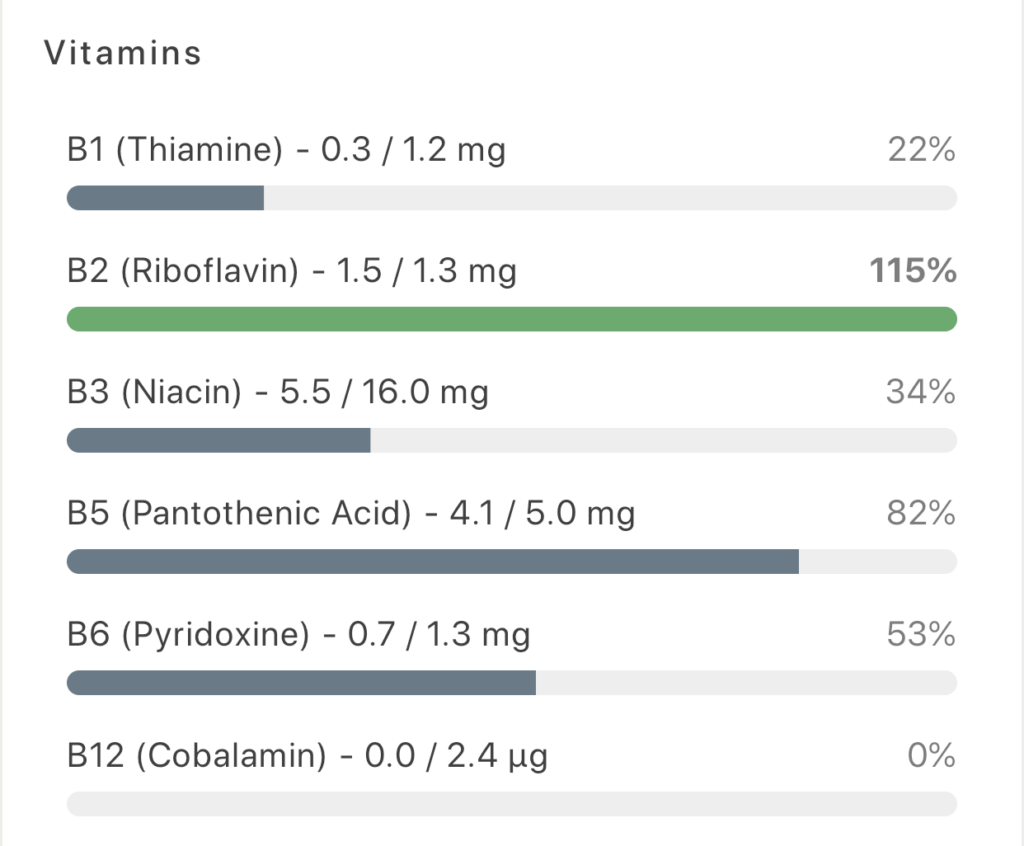
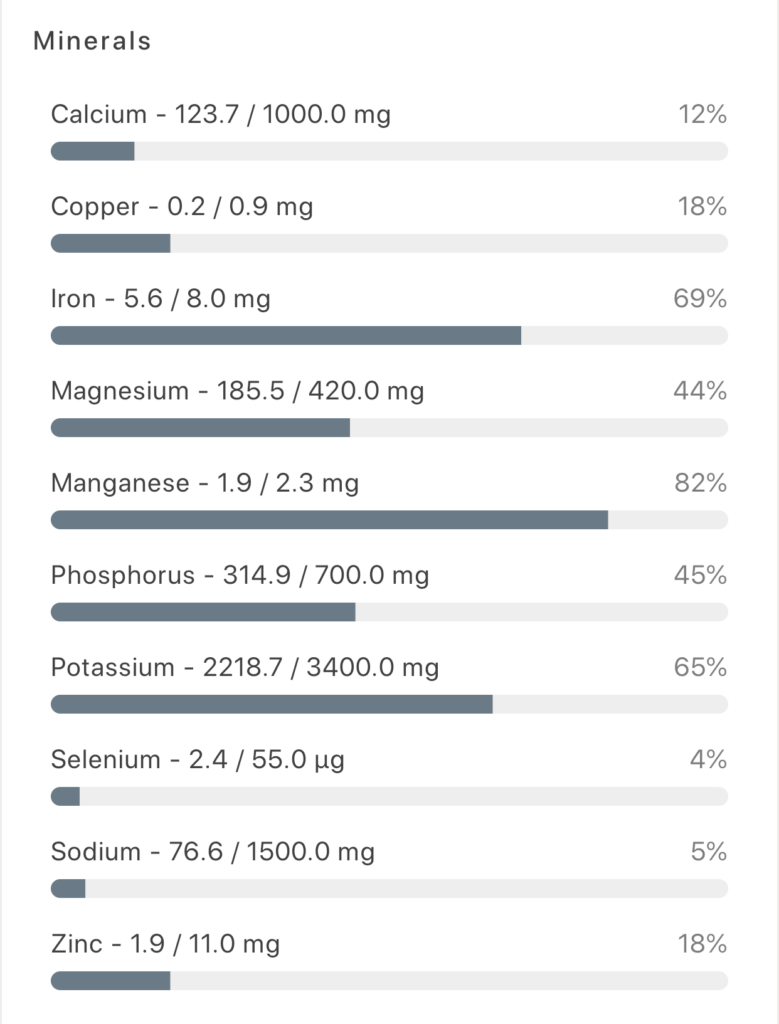
Bizarrely, the brand of corn starch they have at my local Supermarket, Clabber Girl, is fortified with calcium. And nothing else. No other corn starch brand is fortified with anything. It’s like Clabber Girl anticipated my experiment all of those decades ago.
To round out the diet and to feel good about dinner, I had to add some meat. But which one to choose? Clearly the game was to find one that filled out the micronutrient profile while adding the least amount of linoleic acid. Also, it should be tasty and add stearic acid if possible.

Ingredients
Method
- Trim all visible fat from the pork loin and slice it into thin cutlets.
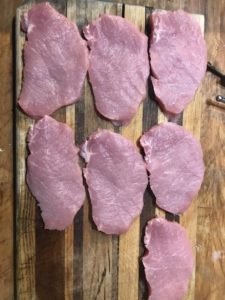
- Put a thick layer of corn starch onto a plate, season it with garlic powder, paprika, black pepper, oregano and rosemary if you're into that kind of thing. Or just leave it plain. Mix everything together. This can also be done in a large ziploc bag shake and bake style.
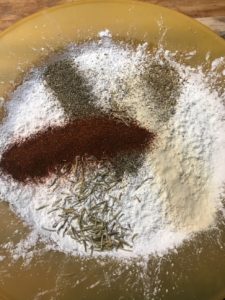
- Salt both sides of the cutlets then dunk them into egg whites.

- Dredge both sides of the cutlets in the starch mixture.
- Fry them on one side in the butteroil on high until they are browned, then flip them and brown the other side. If the fat starts to really smoke, turn down the temperature.

Pork won for the first meal because it has huge amounts of thiamine. Also, breaded pork is delicious and the cutlets absorbed 36 g of the oil. So I ate all of that. My plan was to polish off the meal with a couple ounces of dark chocolate, which really rounds out the nutritional profile. Here is everything together.
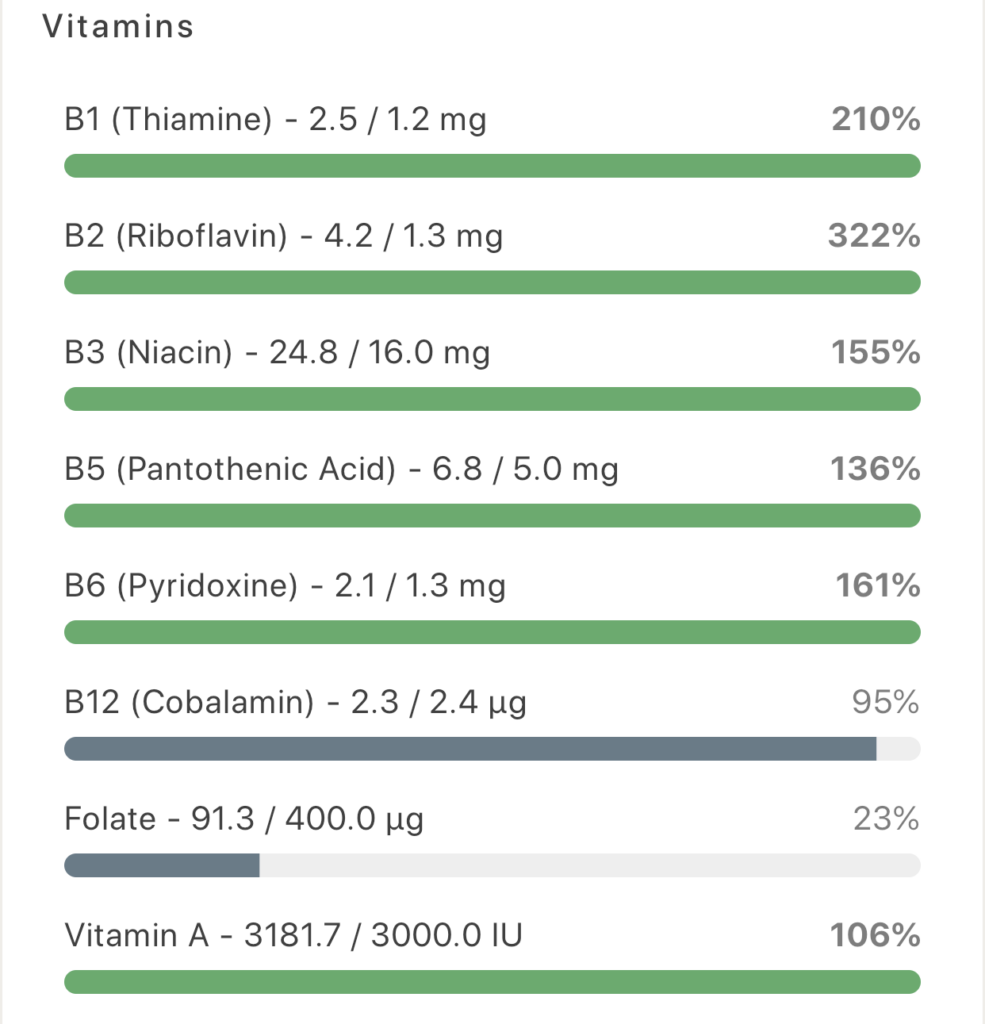
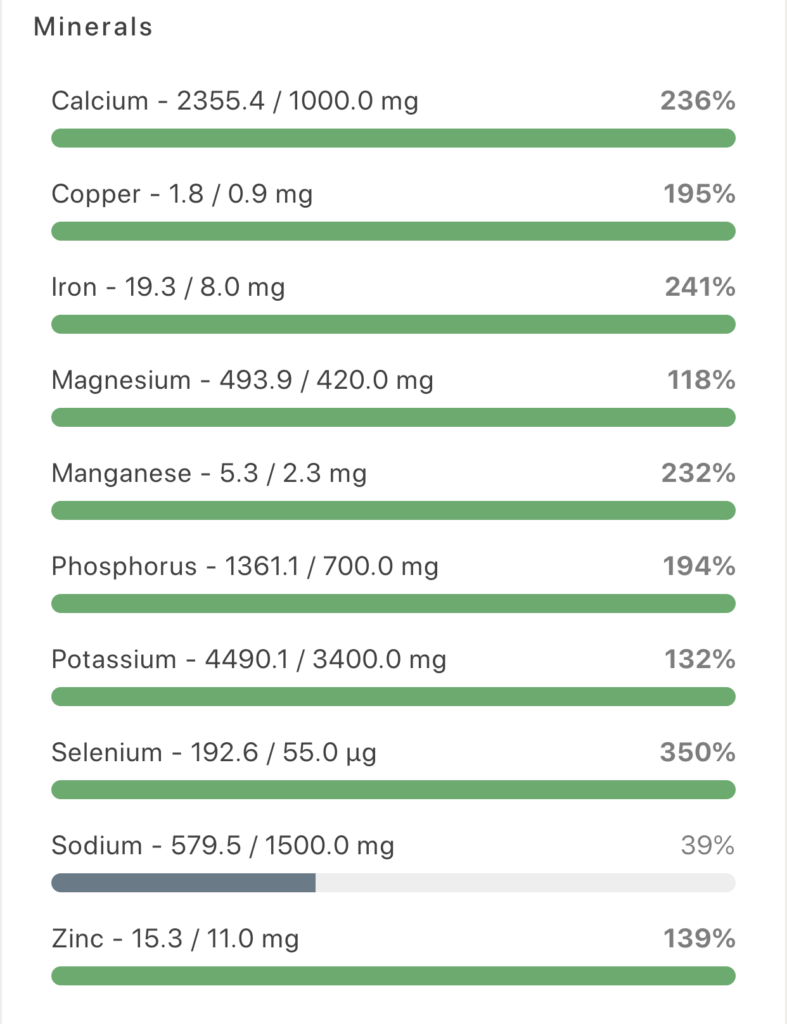
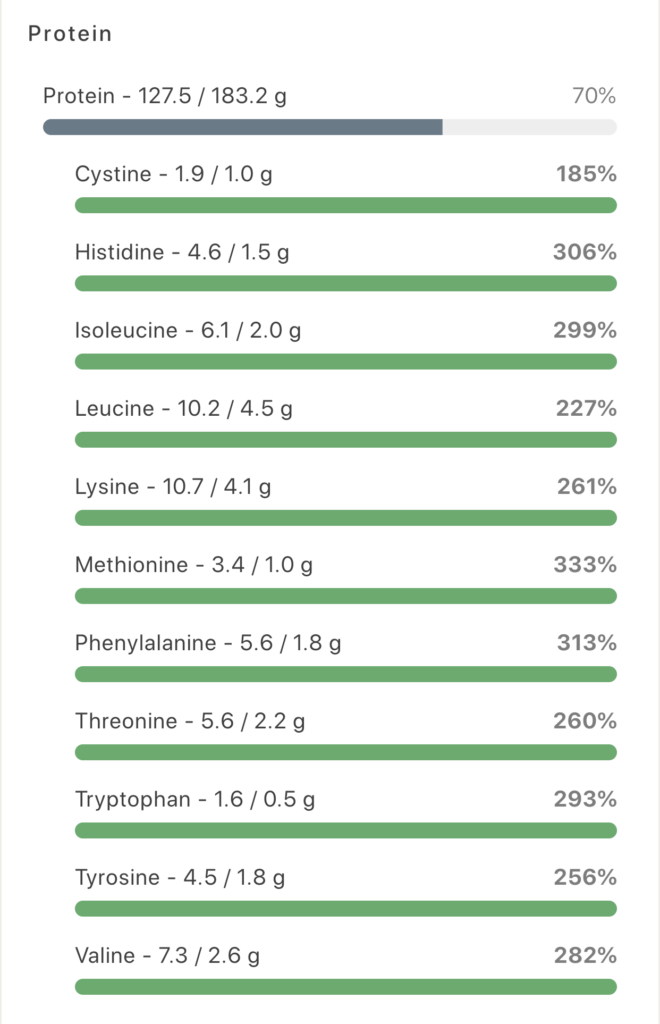
It’s a picture of balance! Even I’m not sure if that’s meant to be sarcastic.
Macro-Dosing
So I filled up a frying pan with hot 40% stearic acid butter. I weighed the pot with the oil. I whipped up a bunch of the pancakes – five to be exact – and I fried them. Then I weighed the pan again. Then I fried 12 Oz of battered pork loins in the same oil. Then I weighed the frying pan again. Then I ate ALL of it. I didn’t save room for the chocolate, so I’ll have to adjust for that next time. This is the whole meal that I actually consumed.
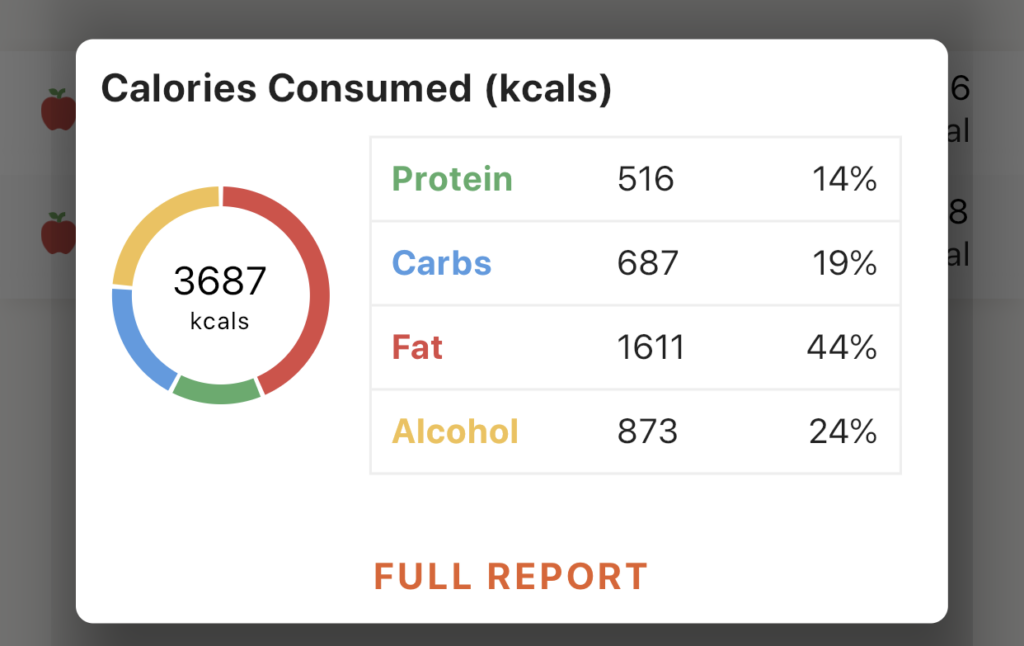
The pancakes absorbed 109 g of the oil and the pork chops absorbed another 35 g, for a whopping total of 144 grams of 40% stearic acid butteroil consumed. The stearic acid content of the final blend comes out around 42% percent because the stearic acid is really only 92% pure and the butter is 10% stearic and 92% of 40% plus 10% of 60% is 42%. I won’t judge you if you don’t want to do the math, I feel pretty confidant about it. 42% percent of 144 grams is a little over 60 grams of stearic acid, about 2.5 times the amount consumed in the banana milkshake study which caused mitochondrial fusion and fat burning. The ratio of stearic to linoleic acid is around 12:1.
Including the maple syrup, here’s how the macros worked out on just the pancakes. This is the portion that I ate Sunday, March 1st:
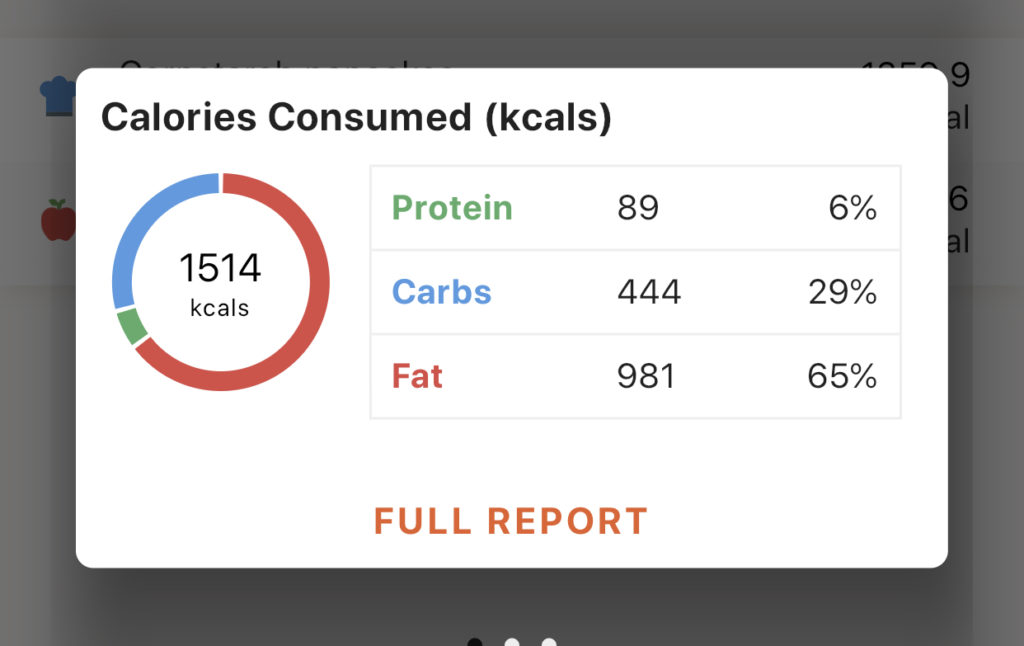
Overall I’m happy with the diet, the final linoleic acid calculation came out to 1.2% and the vitamin B12 is a little low for my liking. My plan is to swap between pork loin and haddock between meals – haddock is loaded with B12 but low in thiamine. By swapping them I’ll get both and they both taste great fried! The haddock also brings some long chain Omega 3 fats into the equation to help balance my Omega-6 to Omega-3 ratio. With haddock the linoleic acid content comes down to 0.8% so I’ll average 1% for the month. Haddock stocks have been declared fully recovered in the North Atlantic and the codfish stocks are recovering so I feel OK about eating them.
Results So Far
I’m writing this on the 6th and I feel great! I’ve had three of these feasts to date and I’ll have another tonight. I’m fasting in between meals in my own way which will be the subject of my next post. The thing is that the high stearic acid feasts make the fasting so easy and fasting makes the feasting so enjoyable. The scale is down a seemingly implausible 9.2 lbs between Monday morning (the morning after the first feast) and Friday morning (I haven’t eaten since Wednesday evening) and I’ve lost another half inch on my waist. My blood glucose this morning was an all time low. By a lot. I’m typically in the 102-108 range. This morning it was 84. Previous low was 95.
I’m bursting with energy! I always pace when I write/think but the last two days especially. According the health app on my iPhone I took over 17,000 steps yesterday WITHOUT LEAVING THE HOUSE. It’s almost 2 PM and I’ve already taken 10,000 steps today. Last night I had an impromptu 45 minute dance party with myself! My basketball buddy referenced in Introducing The Croissant Diet grabbed me half way through last weeks game and asked “are you on the stearic acid again?” He hasn’t asked that in months. He could tell.
I’m not hungry. After the last feast of crispy haddock and pancakes on Wednesday (it’s been 42 hours since I ate a bite of solid food) I’ve felt no hunger. I actually still feel like my stomach is physically full which can’t possible be true. I have a “psychologically full stomach”.
I’m excited to see what the rest of the month brings!

Who KNEW your science, Chef training, farming and butchering would culminate in such a great research project!
I think you are confirming exactly what food history has told us all along, Carbs are not the culprit to chronic disease in as much as the wrong fats, wrong ratios and the resultant damaged mitochondria… What I note with a little more Traditional Fr Diet, the protein was about 24%, it came down to about 17% with stearic acid, leaving traditional portions of starches. BUT had I been a desert eater, it may have come down further for protein. Super interesting work. My weight has stayed the same going from Carnivore to this. The difference is I do not have to work so hard on keeping weight on and the food is 100% more enjoyable! Still love my meat and all its varieties, still support Carnivores and all their achievements too! This is the most fun diet experiment I have done!
Yes! It’s fun! Which is a means all to itself.
And it lets us think about food history in a different light. I think anything that let’s us think about traditional foods in a more healthy way is a win.
Brad
I want to concur that physiological fullness after a meal with stearic acid in it. I can see why the Fr do not nibble all day if they are getting more stearic acid in their diet through all the dairy and meats. Good job!
Yes! It is quite something! And thanks for digging up the quote that the traditional preferred French frying fat is beef suet! That is VERY interesting, as beef suet is the highest stearic acid/lowest linoleic fat out there.
Fascinating as always, Brad. A few comments/queries:
It would pain me to throw away perfectly good egg yolks. Could you not work them in?
Sounds like you are deep frying the pancakes, which makes them more like beignets, the French version of pancakes. Throw in a hole and you have stearic acid enriched, cornstarch donuts! Call them Krispy Korn.
Where did all the calcium come from? I’m concerned about calcium deficiency in pure carnivore diets.
Very likely the fasting (and sodium/water losses) explains the rapid weight loss. But who really cares? Results count.
Speaking of sodium, you need more. At least 3 grams/day.
One more thing: I’d be more confident if you had a confidant, say Shannon, to confide in. Please understand that I only poke fun at friends.
👏🥂😉😎
Haha! Trust me, I get LOTS of sodium. I just don’t bother to enter it into Cronometer because lack of sodium is not something most people worry about.
As to the egg yolks. I couldn’t throw them out, either. Ha! I’ve been buying egg beaters, which pains me nearly as much. I keep telling myself its only for the month. The calcium is because for whatever weitd reason, I’ve been using the Clabber Girl brand of cornstarch which is fortified with calcium.
And not to worry, Shannon and I consult regularly!
Brad
If you are concerned about calcium eat egg shells! Like 40% calcium by weight!Half a shell should give you over a gram.
For context, can you tell us your weight and height? I’m having a hard time understanding the consumption of 3687 daily calories in a weight loss program. Sure everyone’s different. And intermittent fasting with periods of longer fasting can no doubt overcome hi caloric intake. I’m of average height and a touch overweight, but with my tested BMR of 1730 cal, I would never be able to lose weight at that caloric intake, regardless of its content, macros or exercise. You must have a very high metabolism to start with vs. my puny burn rate. I’m just trying to wrap my brain around the crazy range of intake variables sapiens have.
I’m 5′ 9″ and this morning I weighed in at 226 lbs, about 30 lbs down from my peak. I am barrel chested and muscular with massive forearms. I DO think that the stearic acid (or saturated fat in general) increases metabolic rate and allows weight loss with higher caloric consumption, at least for me.
I just made Ghee Rice with a bit of stearic mixed in to the Ghee. I have no idea how much to add on these small amounts but I am working it out!
GHee + stearic acid
Long grain rice
Saffron
salt Pepper
Clove
I did throw in some pork skin to make it gooey like sticky rice, I hope that does not negate SA
Delicious! Carbs per 100g is 25g not bad but I can only eat about 75g of rice! Served next to Chicken thighs cooked from an old French recipe
Brad,
Great stuff. I really like that chart with the PUFA content. Do you have a source for that?
Have you looked into the effects of Methylene Blue on the electron transport chain?
https://www.ncbi.nlm.nih.gov/pubmed/28762173
The paper above links dysfunctional mitochondria and low ATP production with depression. I’d be interested to hear your thoughts.
Thanks for your excellent work!
As to the chart, I just looked everything up at the USDA website:
https://fdc.nal.usda.gov/
AFter you search, uncheck the “branded” box in the sidebar and you’ll get better results. I apply the equation “total linoleic acid times 9 divided by total calories”.
I haven’t looked at methylene blue but I’ll check it out!
Brad
Whole coconut is also below 1% PUFA calories! If I remember correctly, Ray Peat specifically does not recommend high fat because all natural fat sources contain some PUFA. I’ve been interested in reducing PUFA for a while now, though not to this extent!
Btw, aren’t you worried that the (apparent) lack of MUFA will upregulate SCD1 hard?
Cheers and thanks for the experiments and your thorough logging! Always new food for thought.
Although SCD1 IS upregulated by saturated fat and down-regulated by unsaturated fat, I think the main thing driving it these days is insulin. I think by feasting and fasting, I’ll end up having a lot of low insulin periods which will lower SCD1 overall. Maybe.
Well, to be fair, our body (or any mammalian for that matter) seems to desire a certain optimal mix of SFA and MUFA. If you live in colder climates for example then the fat (under the skin) is more unsaturated, and if you live in warmer climates your fat will be more saturated (to retain the proper fluidity).
That’s why I think MUFA is not a bad thing at all! Though if you go to the sauna a lot I presume your fat will be more saturated and taking lots of cold baths will unsaturate it more. Maybe.
I love trying these new ways of preparing comfort foods! For the pancakes, I separated 5 eggs and wisked the whites, but it wasn’t nearly enough liquid for the 3/4c cornstarch. I used a splash of half-and-half to salvage the batter. For the second attempt, I bought a carton of egg white and used about a cup. Also, oddly enough, the pancakes never browned – they stayed “starch” white in both attempts. (dad-pun) They still served their function of butter/syrup delivery! The pork loins turned out amazing, though. I even threw the rest of the egg whites and dredge mix into the last bit of the oil and it made semi-believable grits. Thanks for the inspiration and the science, Brad!
Thanks for the report! I’ll admit, I’ve been using using egg beaters instead of actual eggs because I can’t actually stomach the idea of throwing out perfectly good egg yolks. The carton says it’s the equivalent of ten egg whites and I’ve been assuming its accurate but I guess I should double check!
Here’s an anecdote I’m struggling with at the moment-
I started doing something like TCD about 3 weeks ago but maybe lower carb and less mindful of PUFA, e.g. lots of eggs (surprised at the 9% LA calorie content!), it worked great for a week but during that week we had fantastic weather and I was bicycling multiple days & walking every other. Took no effort at all to meet my fitbit 10,000 step goal and many days I reached my 4000 calorie goal (not sure how accurate that fitbit is but I set that goal because most sedentary days I don’t meet it, by the fitbit’s calculations anyhow)
A major feature of the high sat. fat. diet (beef tallow, mostly, with breakfast at that time, with some butter croissants bought from Walmart or local bakery) was a huge uptick in metabolism – felt downright MANIC driving to work in the morning and all morning long. I did note this metabolic uptick happened whenever I had at least 1 piece of toast or bread with breakfast, or comparable amount of couscous, but was never quite as intense with a keto-style breakfast. This effect (even w/ carbs) seems to have subsided over the past week and a half and I’ve actually felt down/loopy a bit, although I may have some short-term sleep issues contributing too that I’m working out (changing CPAP masks).
I’m wondering now about the role of exercise – particularly of having enough physical activity that your muscles’ glycogen stores are always a little depleted, a little “hungry” for glucose unrelated to insulin, and the potential of sedentary behavior to cause insulin rise and SCD1 production. Anecdotally over the years I’ve always noticed I have an easier time fasting, and feel “fuller” after a meal, if I’ve had recent exercise. This effect has its limits – frequent exercise will make me hungry, but there seems to be a “threshold” where exercise actually makes me less hungry.
So my question to you- how “active” are you on a day to day basis? I understand you run a farm so I’m betting you never have the opportunity to be as sedentary as I am. I’m really wondering if this is one of the key pillars – exercise counts but only a certain amount is needed.
I think the manic effect after a very large meal of saturated fat is real. As to farming, I’m out of the business at the moment, so I spend a lot of time on the couch working on my blog…
But I play basketball weekly, I cut and haul firewood and I pace maniacally. Today it was above freezing for once and I went on a long walk. So I stay active.
I believe the uptick in metabolism is real and a reason why some people experience ravenous appetite when experimenting with TCD/stearic acid supplementation. I don’t think being ravenous is a bad thing! I have plenty of extra fat, so I think that instead of being ravenous, I’m just consuming my own bodyfat, but I expect it to make me ravenous as my fat levels drop.
Today I tried a few things to test my idea; I fasted through lunch except for a decaf latte made with half & half, but I also walked/jogged a couple times during breaks at work (we have a nice nature trail next to the office thankfully). My job is sedentary IT work otherwise.
I was ravenous by 3:30pm after nearly fasting most of the day, didn’t eat anything as I didn’t have anything handy, and at 6pm I started off dinner with a croissant-y appetizer: 1/4c (dry) couscous cooked in boiling water as usual with 2 tblsp of liverwurst and 2.5 tblsp of stearic-enhanced butteroil (~25% stearic acid by my math) added after. Then we walked to a pizza joint, I tried a slice of pizza and ate my main dish- a cheesesteak (skipped the au jus as it looked to have thin PUFA-y oils in it, skipped the fries too, they’re canola-oil-fried).
My lingering hunger pangs were still present by the time we ordered, but subsided as I ate (probably the couscous taking time to digest) and as the meal went on I felt more and more full, a certain subtle “burning” sensation throughout my body like I get every other time I feel the metabolic uptick, and the rest of the evening I’ve been hyper – after reading to the kids & putting them to bed I walked for 2.2 miles and here I am, still not tired in the slightest. Could probably go for a 2 mile jog or 5 mile bike ride.
I’m thinking the fasting – and only eating when truly hungry – is a big piece of this, possibly in concert with exercise (the two may stand in for one another at times). Then the stearic acid+starch effect lights your metabolic rate on fire.
Side note, reading about adipocytes and ROS-
https://www.ncbi.nlm.nih.gov/pmc/articles/PMC6240632/
“It is now documented that oxidative stress induces insulin resistance of adipocytes and increases secretion of leptin, MCP-1, IL-6, and TNF-α by adipocytes.”
I wonder if Leptin is the missing link here? Leptin stimulates the sympathetic nervous system, which neatly describes the feeling I get when I’m all hyper.
https://www.frontiersin.org/articles/10.3389/fendo.2018.00089/full
“The Newly Discovered NSAPP Signaling Pathway is Essential for Canonical Leptin Signaling in Hypothalamic Neurons”… Not a molecular biologist so I’m curious what your take is on this!
Hi! Sorry about the long delay in approiving this. Somehow a group of messages from March got buried as COVID was taking off. Very interesting post, though.
Yes! I believe that hydrogen peroxide production in the hypothalamus plays a major role here. Keep an eye on the blog for an upcoming series.
Can you provide measurements of everything you are eating in a day? ie, 2 6-oz glasses wine, 3 6-oz cups of coffee, 1/2 lb pork loin, etc.? We tried the croissant diet with high hopes after coming off of keto but gained weight. I suspect we are flying too loose and need more specifics. Neither of us got ‘totally full’ the way you describe, so I wonder what we need to do differently to make this work?
Also, in a previous post you mention that Grassfed beeffat is an excellent source of Stearic Acid, but grassfed beef is also a big source of Conjugated Linoleic acid – more then regular beef. Wouldn’t this be a bad thing or is it that the regular beef’s linoleic acid is not as conjugated?
Thanks,
Michelle
Specifically, I was talking about grassfed beef suet (kidney fat), which is much higher in stearic acid than other parts of the beef. The actual amount of CLA is typically very small compared to the amount of linoleic, so I wouldn’t worry about it.
I’m curious what your macros were. As you can see from this post I’m consuming a LOT of stearic acid to give the satiety effect. The calorie count and macros are pretty accurate on the feast meal, but I’ll break it down:
I ate 12 Oz of pork loin, crusted with 32g of starch
I ate five of the pancakes, about 2/3 of the recipe in the article, plus 3 tbsp maple syrup
Those two things collectively soaked up 144g of the 40% stearic acid fat
I drank a bottle and a half of red wine
I drank 6 6-oz cups of coffee.
That’s a big meal and as I’ve repeated similar meals my consumption has naturally drifted down a bit. Also, I’m restricting my eating window, which is important. I found it to be easy with enough stearic acid in a meal. After a big meal like this I might exist the next day on coffee and red wine. If I’m eating every day, the meals will drop by a couple of pancakes.
Dr. Herman Taller in his book “Calories don’t count” 1961 explains how a high linoleic acid intake ,at least 90 ml safflower oil, caused his patients to lose fat till they reached 11% body fat.
So this is an interesting point. There is quite a bit of data that level of unsaturation might be a U-shaped curve – meaning that if there’s very little or very much PUFA, your fat cells will be insulin resistant and you’ll stay slim but if you’re in the middle you’ll be fat. This makes sense – high dose Omega-6 PUFA oxidizes which produces lipid peroxides such as 4-HNE, which will knock out insulin signalling the same way that hydrogen peroxide does.
The problem with this approach is that 4-HNE ALSO, unlike hydrogen peroxide, causes DNA and protein adducts, which is to say damage. Probably not the best approach, IMO.
Brad
I looked up the linoleic acid for buckwheat and Wikipedia has it at ~1%, so I made buckwheat pancakes fried in fiab stearic mixed with kerrygold butter, plus stearic in the batter. A little tapioca flour for fluff. I left in one egg yolk of 3 eggs worth. Served with maple syrup and sour cream, yum.
So I’ve been eating a LCHF style of TCD (despite that being a complete contradiction lol…) basically a high SA keto diet. Meals center around fatty ribeye, non starchy veggies, a handful of berries sometimes, ghee/stearic acid mixture I make using your SA, eaten with Lily’s chocolate, which has a high amount of cocoa butter, but the one item I struggle to eliminate are my beloved Epic pork cracklings. I LOVE them, and eat a couple ounces a day usually. While I feel better about the sourcing of pig skin for items from Epic, I think they use pasture raised pigs, I know this is messing with the linoleic acid ratio. How much impact do you think the cracklings have on the efficacy of the diet ? It’s the only thing I’m consuming that’s not recommended….
I’m sure most people can get away with a couple of cheats. Like I say, during my initial test, which went great, I was eating pork sausage and whole eggs. I’m trying this month to take the concept to its ideal and see what happens. One good thing about pork rinds is that they are the single best free source of glycine, which helps your body manage its antioxidant levels.
If you want to decrease linoleic acid even more, you could try Hydrogenated Coconut Oil. On the data sheet I saw, it was 98% saturated, had zero PUFA, and 1.5% MUFA (0.5 of which was Trans Fat). Stearic Acid was about 10%, higher than regular CO, because linoleic and oleic were turned into Stearic.
Yeah, I know there is a stigma to hydrogenation and trans fats, but isn’t there also a stigma with Saturated Fat and Free Radicals? Of note, only PUFA can turn into Trans Fats, which themselves are MUFA, and act more like SFA.
That’s interesting. I’m not knee-jerk anti hydrogenation. It’s not my FAVORITE thing but I’ll consider most things. A concern I have with coconut oil is that I have questions about whether the short chain saturated fats have the same effect as the longer chain ones.
Thank you for sharing your n=1 experiments!
I’m trying to fit as many pieces as possible together. Here are a few questions and findings that I would need clarification on:
– The few clinical meal studies that have been done do not appear to point to SFAs being more satiating than PUFAs. Do you believe this is due to PUFAs still being to high on the SFA diets?
– A high SFA content in the diet appears to lead to increased inflammation and insulin resistance (not just physiological postprandial insulin resistance). Also an issue of SFAs (and type of SFAs) being in “the wrong context”?
– Do you believe that postprandial insulin resistance is different in different tissues depending on type of fat in the meal? And is that the clue to why a croissant diet could reduce fat mass?
Some clinical studies have shown increased satiation: https://high-fat-nutrition.blogspot.com/2016/03/boiled-mashed-potatoes-for-miracle.html
I suspect in others, they perhaps had circulating PUFA and/or fat wasn’t saturated enough to overcome said PUFAs.
In terms of SFA leading to general inflammation, I doubt you’d see that if you looked at the French population in 1970, I think it’s centext dependent. Here’s an article about saturated fat lowering LPS – an inflammatory marker – compared to olive oil. https://fireinabottle.net/butter-may-lower-lps-mediated-inflammation-compared-to-olive-oil/
I absolutely believe that postprandial insulin resistance can be different in not only different tissues but even between cells within a tissue in the beginning and end of a capillary bed (for instance).
Hi Brad,
I was wondering, for those of us who are skinnier and would rather gain weight, but still want lower inflammation for health purposes, is it possible to gain mass on this diet?
I know the rats in the one study had more lean mass as well, but I wonder if that implies more of a weight-stable recomposition rather than an increase in total weight as well, which would be preferable for us scrawnier folk.
Thanks so much,
Dave
My opinion is that the increase in lean mass is real. In the first experiment I felt like my weight loss was minimal compared to the loss in my waistline. My presumption is the reason for the disparity was increased lean mass. I’d love to hear your results, though!
What food macros are you aiming for in combination with <1% linoleic acid?
IDK about “aiming for”, but I’ve been landing at around 15% protein, 20% carbs, 45% fat and 25% alcohol. That adds up to 105%. I’m sticking with it.
Brad
You could mix fractionated coconut oil with stearic acid and probably get some mct and high S.A. regarding pancakes you could also make a topping like we do with pavlova…..2 parts heavy cream to 1 part moscarpone. Also use on the chocolate cake. Alternative on sweetened starch…creme fraiche..
But this militant diet you are trying, not sure about it. Moving away from culinary arts with real food, next week making our own croissants. I love my small chocolate babka breakfast. Very satiating. Don’t have to eat lunch
Militant…somewhat harsh. I meant extreme diet challenge. A good experiment and looking forward to result. But may not be practical for most. ONe way of achieving the mito biogenesis associated with fat oxidation is to deprive carbs, but alternative includes activity although in a monitored and narrow band of effort for reasonably long time. Generally known as Maffetone or HR Zone 2 endurance training. This will force max fat burning with minimal glycogen consumption for energy. Once that machinery engaged body more adapted and accepting of the kind of fat your diet will provide. Diet is more important but eveything counts. Drifting into anaerobic zones will not be so helpful and could block the desired result..
Ha! My personality is the furthest thing from militant. But I DO love ratios…
Anyway, after the world fell apart and I stocked up to avoid going back into civilization, this trial unfortunately was ended prematurely. I’m still having good overall results from the second TCD trial and I intend to keep doing it. I’m probably still below 2% LA currently.
How do we plead for a copy of the chocolate cake recipe?
Unfortunately I don’t have it myself. But you can track down recipes for German Chocolate spongecake, whipped ganache, vanilla mousseline cream easily enough. The frosting is just whipped cream and powdered sugar.
wht is difference between cornstarch, Waxy maize, and maltodextrin?
Corn starch comes from waxy maize. The starch in normal corn is a mix of amylose – a straight chain starch – and amylopectin – a highly branched starch. Waxy maize contains only amylopectin. Waxy maize is all amylopectin, that is what corn starch is made from.
Maltodestrin undergoes further processing of cornstarch – heating and enzyme treatment. So it’s its own type of starch.
For methylene Blue…there are tons of articles.
This one is an exceptional review of MB in AD. MB is an electron donor to the ETC.
https://www.frontiersin.org/articles/10.3389/fncel.2015.00179/full
I know I seem like a total troll here lol – but I am seriously interested in this only because it is such a nice way of eating. But yes…I gained weight from a baseline of already overweight bmi 26 (so not too bad) but prediabetic with very high cholesterol and triglycerides….I digress….anyway so I gain mixing starch with saturated fat (from butter and tallow) – I don’t get an appetite reduction if anything I am more hungry…but I do get a temperature increase. Also I would like to add that in the past the leanest I ever was was doing Atkins Induction but hardly any saturated fat!! I was eating loads of store bought mayo which is mostly soy oil based, next to no dairy and a lot of fatty pork and salmon!! All my stats were excellent – I got in fact a bit too lean for being a woman for me – around 19% body fat…and I found in the long run I craved fruit so that’s why I didn’t stick with it. I didn’t restrict calories…I was also adding a lot of olive oil to the salmon and frying the heck out of it until it was almost burnt.
Hey Luoisa!
You’re not a troll! You’re adding to the knowledge base and everything is important.
Your case is actually (perhaps) the exact case I was thinking of in the original Introducing The Croissant Diet post in the section called something like: Why I Worried It Wouldn’t Work. Butter and Beef Tallow are prob great choices for this is if you’ve avoided PUFA your whole life and have a healthy metabolism. For most of us, those things won’t be true and what goes into your mitochondria is a mix of stored fat and dietary fat. If your stored fat is highly unsaturated and your dietary fat is not that saturated, I wouldn’t expect you to see the benefits of this and it seems like you didn’t.
Brad
Doesn’t bitter cocoa and 100% dark chocolate contain linoleic acid?
Every single natural fat contains linoleic acid. Cocoa butter (and thus chocolate) is one of the lowest.
Thank you for sharing your n=1 experiments!
I’m trying to fit as many pieces as possible together. Here are a few questions and findings that I would need clarification on:
– The few clinical meal studies that have been done do not appear to point to SFAs being more satiating than PUFAs. Do you believe this is due to PUFAs still being to high on the SFA diets?
– A high SFA content in the diet appears to lead to increased inflammation and insulin resistance (not just physiological postprandial insulin resistance). Also an issue of SFAs (and type of SFAs) being in “the wrong context”?
– Do you believe that postprandial insulin resistance is different in different tissues depending on type of fat in the meal? And is that the clue to why a croissant diet could reduce fat mass?
Hi! Good questions. I’m going to answer them to the best of my knowledge. Don’t bank on any of this.
SFAs in clinical studies. Results seem to be mixed. None of them I’ve focus on stearic acid. There may be something special about 18 carbon length fats. Also, many of them test a single meal. But the current meal is affected by previous meals, so I think many of them are not done in a long enough trial.
In terms of SFA causing inflammation and IR. I have trouble believing this is real. I’d have to look at specific studies but I think all inflammation and all insulin resistance is local. Each cell type and individual cell has it’s own biology and it depends on the cells preferred fuel source, etc. It is conceivable that a switch to a high SatFat diet after the SAD diet could induce oxidative stress via increased ROS production and high linoleic acid content of cardiolipin but that is quite speculative.
I DO believe insulin resistance is different in each cell type. Abdominal fat has the highest LPL activity of all tissues (I think) and therefore is the most easily targeted by dietary fat.
Brad
0 to 4% LA. Probably 3%
I’ve got a slight allergy to alcohol so I’ve been avoiding it. I tried your induction diet above, but find I’m still hungry. Do you have any thoughts on what else we can substitute in for the wine to help with feelings of satiety? I’m thinking I must not be getting enough calories. Also, do you have a link to a website that shows linoleic acid content on other foods?
Hey Patti!
The only macros I know that definitely don’t raise insulin levels are alcohol and fructose but I don’t recommend the latter. Obviously not everyone tolerates the levels of alcohol I do.
Without the alcohol I would recommend simply increasing eating frequency. In my first trial I altered between one and two meals per day and lost weight easily. Also, it takes time to build up to being able to fast. I’d love to hear your results if you stick with a very low-PUFA, high stearic diet for a few weeks without alcohol and eating often enough to keep you out of hunger.
Brad
Brad
Also! Check out https://fdc.nal.usda.gov/ for linoleic acid content. Unfortunately the site is stuffed with commercial listings. Once you search unchecck the BRANDED bow under “Filter Search Results”. If you’re on a cell phone, add the word legacy to you’re search. So, use “butter legacy” instead of “butter”. The line for linoleic acid content is “18:2” under the polyunsaturated fat section.
I’ll try to get a more comprehemsive list up!
Thanks,
Brad
Wondering how long til you get the 2# of butteroil/steric acid ready to ship?
Also, I understand from what you’ve been writing that steric acid is waxy etc, but how hard is it to get it to mix with things, in general, if I wanted to play around with adding it to my diet? I see here you added extra to the pan with the pork, is that easy for an average cook since you’re heating it? How about mixing it into things that you cool…thinking maybe some MCT oil (which I know is different than TCD protocol) because my body likes that a lot but dairy is iffy (the butter oil should be ok since it’s casein free)….just playing around with ideas.
I haven’t read all your comments so I apologize if you’ve already answered this, just point me in the right direction. Thank you!!
Hi Katie! Sorry about the slow reponse. Strange times, I haven’t had the time to keep up but I’m working out the balance now. How has it gone?